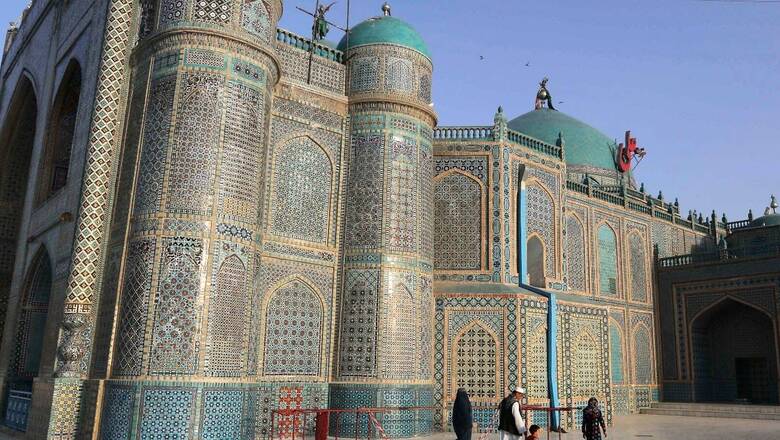
views
After 20 years, the Taliban have launched a multi-pronged assault on Mazar-e-Sharif to gain back control of the major city in northern Afghanistan defended by powerful former warlords. The Taliban has secured multiple launch pads to target Mazar-e-Sharif in the adjoining province of Balkh. After seizing control of militarily neglected Sari-pul, the Taliban has now encircled strategically significant Mazar-e-Sharif from three sides – Kunduz in the east and from Sar-i-Pul and Jowzjan in the west.
Sensing an attack on the Mazar-e-Sharif, India on Tuesday started evacuating its staff from the Afghan city and advised its citizens in Afghanistan to make immediate travel arrangements to return home before commercial air services are discontinued in view of the rapidly escalating violence by the Taliban in several provinces there. The Indian-based staff of the consulate is being evacuated in an aircraft due to the deteriorating security scenario in the city as well as areas around it, people familiar with the development said.
ALSO READ | Afghan President Ashraf Ghani Says ‘Remobilising Security’ Top Priority Amid Reports of Resignation
“A special flight is leaving from Mazar-e-Sharif to New Delhi. Any Indian nationals in and around Mazar-e-Sharif are requested to leave for India in the special flight scheduled to depart late today evening,” the Indian consulate in Mazar-e-Sharif tweeted earlier in the day.
This is the third time in about 40 years that Mazar-e-sharif will once again play a role in the military engagement to gain control of Afghanistan.
Strategic Location and Demography
Mazar-e-Sharif or Tomb of the Exalted is situated between the Hindu Kush Mountains and the Amu Darya River, and was known as Bacteria in ancient times. It was a critical junction in the east-west and north-south pathways.
In fact, even to this day, the Mazar-i-Sharif Airport is also used by NATO-led forces, including the Afghan Air Force.
The Mazar-e Sharif is located in the land-locked country’s one of the most fertile regions, extensively irrigated by the Balkh River and producing cotton, grain, and fruit. The main industries include flour milling and the manufacturing of silk and cotton textiles.
Besides, the region is connected by road and air with Kabul, 200 miles (320 km) southeast, and other Afghan cities and is the country’s chief transit point for Central Asian trade. The inhabitants of Mazar-e Sharif are mainly Uzbeks, Tajiks, and Turkmens.
The town derives its name from the reputed tomb of the caliph Sharif Alī, son-in-law of the Prophet Muhammad, which was later destroyed by Chengiz Khan. In the 15th century, a blue-tiled mosque and shrine were erected on the site.
Afghan tradition holds that the tomb was first discovered by revelation in the 12th century and the original shrine was destroyed after the Mongol invasion in the 13th century. The tomb is venerated by all Muslims, especially Shias.
Mazar-e-Sharif is also the location of consulates of India and Pakistan for trading and political links.
The close proximity to the natural gas resources of Sheberghan led to the construction of a gas power plant in Mazar-e-Sharif.
The most important of Afghanistan’s three existing railway lines connect Mazar-e-Sharif to Hairatan station, which is situated exactly at the border with Uzbekistan and is currently run by the latter’s railways. It further connects to Russia.
Brief History
It was only in 1852 that Mazār-e Sharīf came under Afghan rule and became the political hub of Afghan Turkistan in 1869. But in 1979, after their military intervention, Soviet forces established a military command in the town. It was later the site of brutal fighting and atrocities between competing Afghan factions and changed hands several times.
The city was controlled by the Taliban from 1998 to late 2001, when it was taken with little violence by a coalition of Afghan, U.S., and allied forces; a subsequent uprising at a prison there holding Taliban troops and their allies, however, left hundreds dead.
At 10 am on 8 August 1998, the Taliban entered the city and for the next two days drove their pickup trucks “up and down the narrow streets of Mazar-i-Sharif shooting to the left and right and killing everything that moved—shop owners, cart pullers, women and children shoppers and even goats and donkeys.”
Over 8,000 noncombatants were reported killed in Mazar-i-Sharif and later in Bamiyan. The Taliban further forbade everyone from burying the corpses for the first six days, which is contrary to the injunctions of Islam that demand immediate burial, while the remains rotted in the summer heat and were eaten by dogs.
The Taliban also reportedly sought out and massacred members of the Hazara, while in control of Mazar.
Post 9/11
Following the September 11 attacks in 2001 in the US, Mazar-i-Sharif was the first Afghan city to fall to the America-backed Northern Alliance (United Front).
The Taliban’s defeat in Mazar quickly saw its rout from the rest of the north and west of Afghanistan. After the Battle of Mazar-i-Sharif in November that years, the city was officially captured by forces of the Northern Alliance. They were joined by the United States Special Operations Forces and supported by U.S. Air Force aircraft.
As many as 3,000 Taliban fighters, who surrendered were reportedly massacred by theUS-backed forces after the battle, and reports also place U.S. ground troops at the scene of the massacre.
Read all the Latest News, Breaking News and Special: Live-updating IPL 2022 auction tally | IPL Mega Auction Live Updates here.




















Comments
0 comment